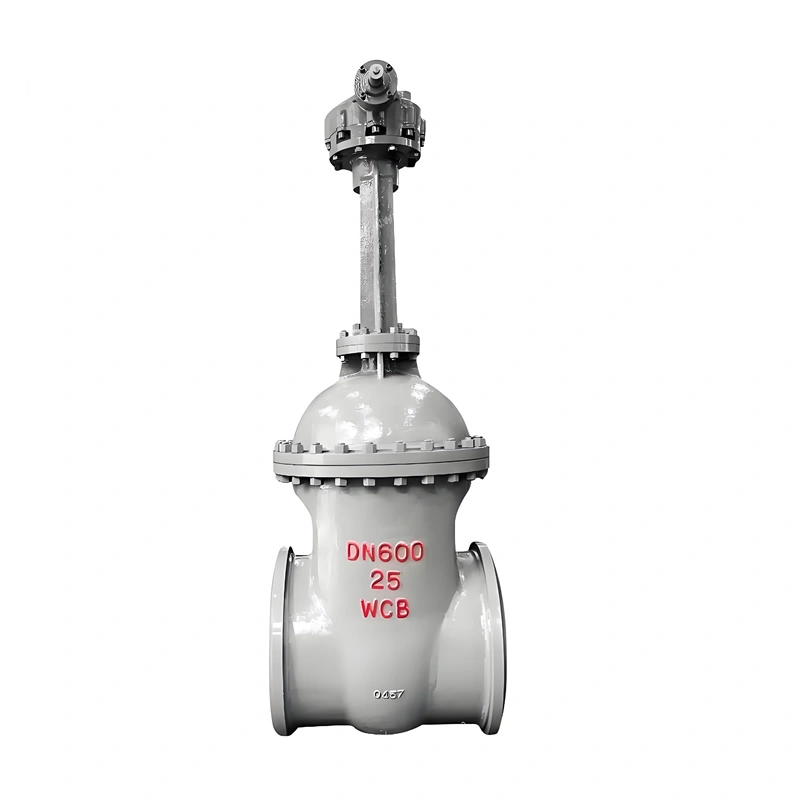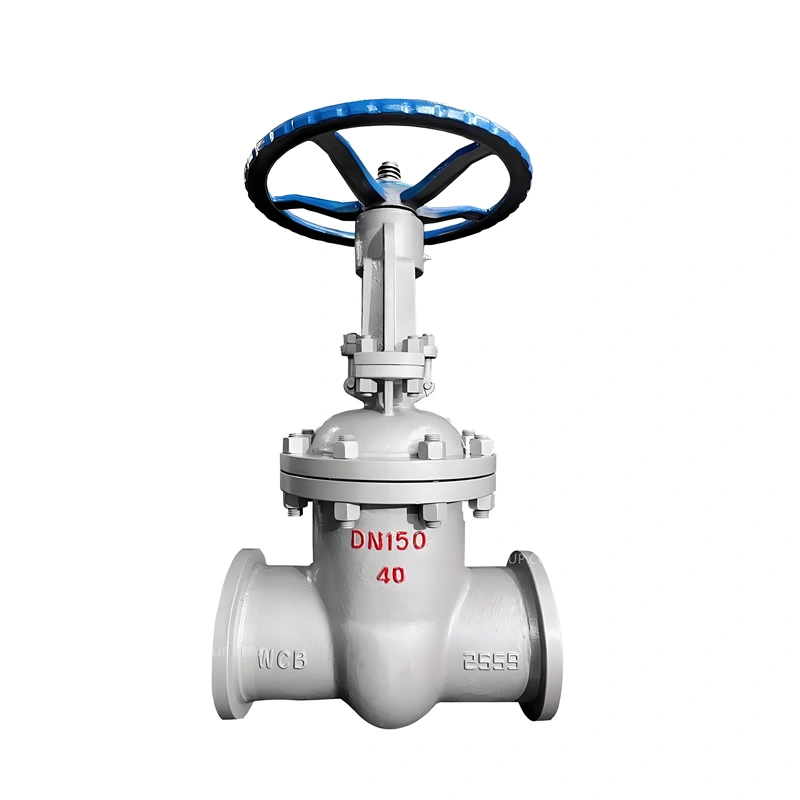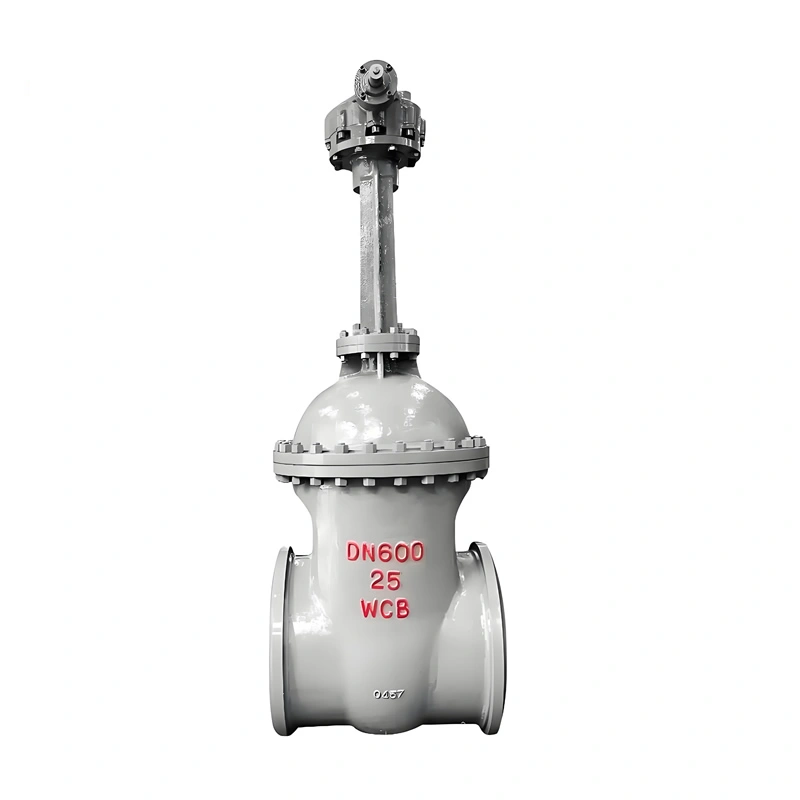- Butt Welding
- Wedge Gate Valve
- En 1984, En 10434
- En1092-1
- En 12266
- DN50-DN600
- Pn10-Pn160
- API 6D, CE, ISO9001, Eac 010/032, API 607, Sil, Is
Specification
DN600 Manual Full-Bore WCB Cast Steel Wedge Gate Valve
I. Product Overview: Efficient Interception for Large-Diameter Pipelines
Newway’s DN600 full-bore WCB cast steel gate valve is specially designed for large-diameter pipeline systems in petroleum, chemical, and natural gas industries. Featuring a full-bore flow path and wedge gate structure, it ensures unobstructed medium flow. Constructed from WCB cast steel (ASTM A216), the valve complies with international standards like API 600 and ASME B16.34, suitable for Class 150~Class 600 (PN16~PN100) pressure classes and -29℃~425℃ temperature ranges. It stably controls the interception and flow of media such as water, crude oil, natural gas, and refined oil. Its core advantages lie in the low-flow resistance of the full-bore design and the high-strength impact resistance of WCB material, meeting the harsh requirements of petroleum refining, long-distance pipelines, and offshore platforms.
II. Key Attribute Parameters: Comprehensive Technical Specifications
|
Parameter Category |
Technical Indicators |
|
Nominal Diameter Range |
DN50~DN1200 (NPS2″~NPS48″), focusing on DN600 large-diameter specifications |
|
Pressure Class |
Class 150, 300, 600 (PN16, PN25, PN40), suitable for medium-high pressure pipeline systems |
|
Execution Standards |
Design: API 600, ASME B16.34; Face-to-Face: ANSI B16.10; Flange: ANSI B16.5 |
|
Material System |
– Body/bonnet: WCB cast steel (ASTM A216, tensile strength ≥485MPa); |
|
Connection Types |
Flanged (RF raised face/RJ ring joint), Butt Weld (BW), compliant with ANSI B16.25 welding groove standards |
|
Operation Modes |
Manual (with handwheel/bevel gearbox), electric (explosion-proof optional), pneumatic, supporting DCS remote control integration |
|
Applicable Media |
Non-corrosive industrial fluids such as crude oil, refined oil, natural gas, water, steam, neutral salt solutions |
|
Temperature Range |
-29℃ (low-temperature conditions)~425℃ (high-temperature steam), adapting to full-process temperature changes in petroleum industry |
Product Overview
III. Core Features: Optimized Design for Large-Diameter Pipelines
Full-Bore Flow Path Design
The flow path diameter matches the pipeline inner diameter (DN600 flow path ≥600mm), with a flow coefficient Cv 40% higher than reduced-bore valves, reducing pressure loss by 35%. Field tests in crude oil long-distance pipelines show that the pressure drop of the DN600 valve at 10m/s flow velocity is only 0.2bar, significantly improving pipeline transportation efficiency and reducing pump power loss.
Wedge Elastic Gate Technology
The gate adopts a single-lobe elastic structure, compensating for temperature deformation (thermal expansion coefficient 1.2×10⁻⁵/℃) through a central groove, ensuring tight fit with the seat under -29℃~425℃ temperature fluctuations and avoiding jamming. The sealing surface is overlaid with hard alloy on the body material, with surface hardness reaching HRC45~50, doubling the erosion and wear resistance, suitable for crude oil media with minor solid particles.
Multi-Sealing Structure Design
Main Seal: Metal hard seal between seat and gate, meeting API 598 bubble-tight standard (leakage rate ≤0.15×DN mm³/s);
Auxiliary Seal: Stem uses double seals of V-type packing + O-ring to ensure external sealing reliability under high pressure. The packing gland is designed for online replacement without valve disassembly.
Operation Mechanism Optimization
The manual type is equipped with a large-diameter handwheel (DN600 handwheel diameter ≥600mm), with operation torque ≤400N·m, supporting single-person operation; the electric type can be equipped with an intelligent actuator (protection class IP68), integrating opening feedback and fault diagnosis functions, adapting to the automation control needs of petroleum platforms.
IV. Manufacturing Processes: Precision Control for Large-Diameter Valves
Casting and Pretreatment Processes
The valve body uses resin sand precision casting, with gating positions optimized by flow simulation to reduce shrinkage and slag inclusions; the blank is annealed at 900℃ to eliminate casting stress, with hardness controlled at HB170~200;
WCB material strictly controls sulfur and phosphorus content (S≤0.05%, P≤0.04%), verified by spectral analysis and tensile testing to ensure mechanical properties comply with ASTM A216 standards.
Machining and Surface Treatment
CNC vertical lathes machine the valve body flange surface with flatness error ≤0.05mm/m and roughness Ra≤12.5μm; sealing surfaces are ground by special grinders with flatness ≤0.01mm and roughness Ra≤0.8μm;
The stem is quenched and tempered (hardness HB220~250) and chrome-plated (coating thickness ≥20μm), tripling corrosion resistance, suitable for humid offshore platform environments.
Full-Process Quality Control
Pressure Testing: Each valve undergoes 1.5x design pressure shell strength test (30-min hold) and 1.1x pressure sealing test (15-min hold), with soap water for external leakage detection and bubble method for internal leakage;
Nondestructive Testing: 100% magnetic particle inspection (MT) for valve body surfaces, 100% radiography (RT, Grade II qualified) for welds, ensuring no defects like cracks or pores;
Life Testing: Sampling for 3,000 on-off cycle tests, with sealing surface wear ≤0.1mm and operation torque change ≤15%, meeting the petroleum industry’s 10-year design life requirement.




